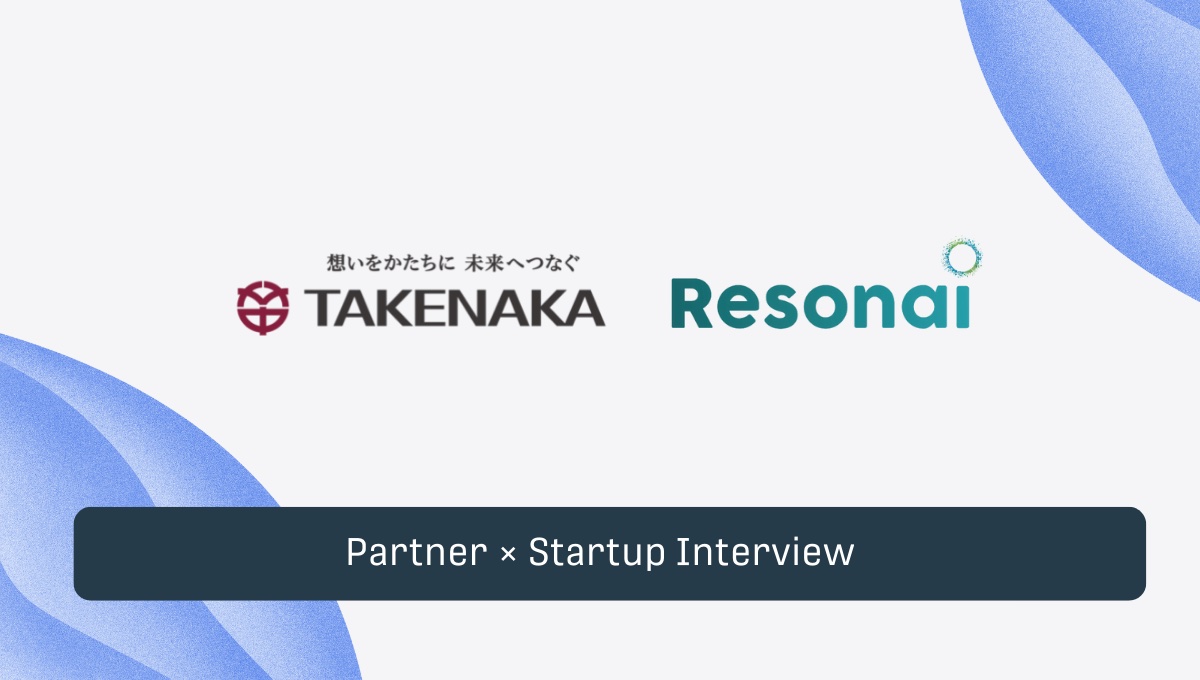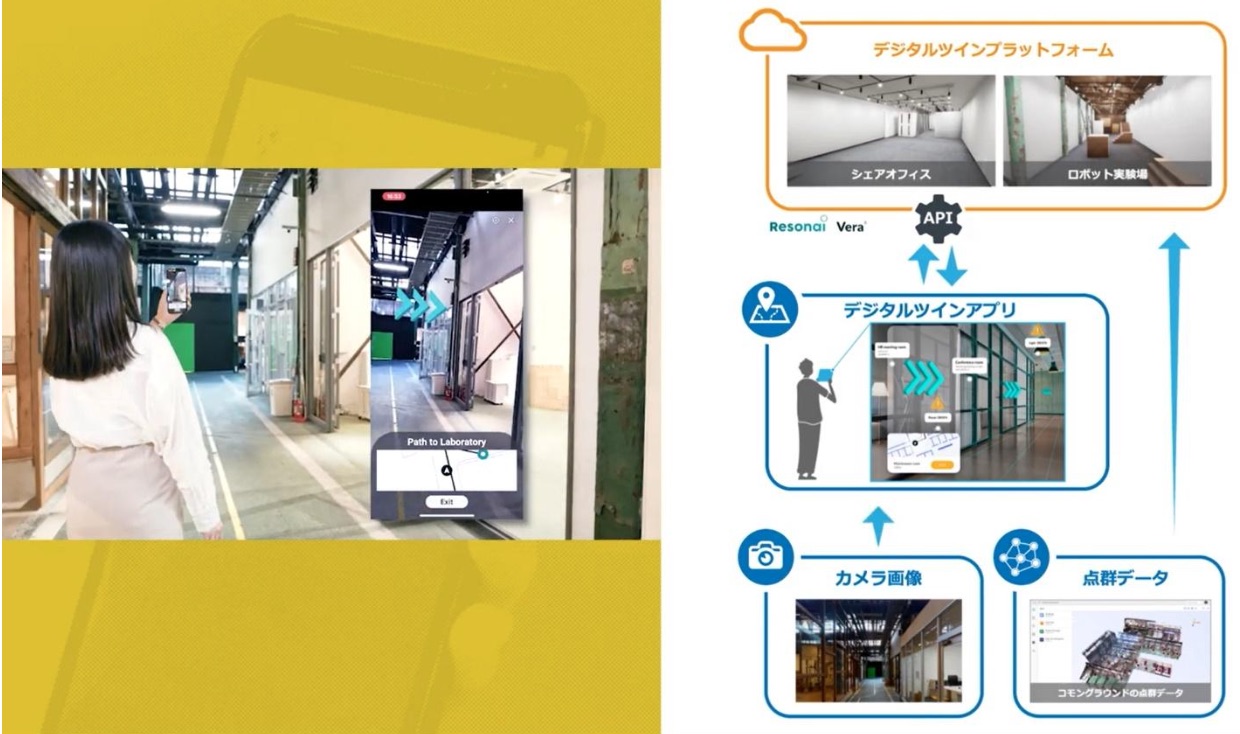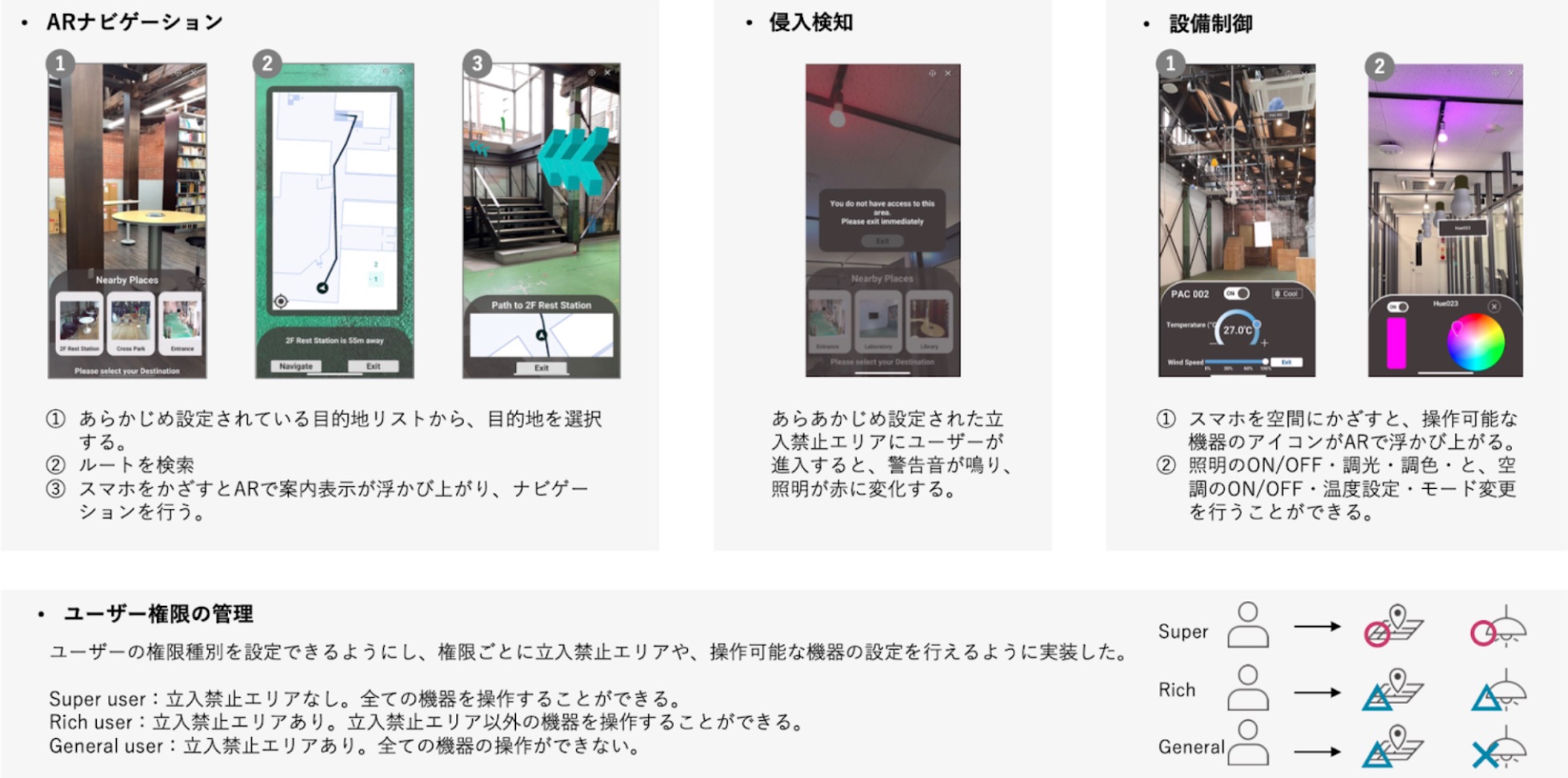Creating Cities of the Future with Digital Twin Technology
| Interview with Resonai Inc. x Takenaka Corporation
2022/07/19

In 2020, the Ministry of Land, Infrastructure, Transport, and Tourism launched a development acceleration project “Project PLATEAU”, a project to develop and utilize 3D urban models that reproduce real cities in cyberspace and convert them into open data in order to promote the digital transformation of urban development, including smart cities. More recently, expectations of 3D urban models and what they can help deliver have grown. Today, a full digital twin and accurate visualization of physical properties is needed, plus the ability to launch innovative experiences, with the aim of realizing a sustainable, human-centered city that supports modern, diverse ways of living.
TAKENAKA CORPORATION (hereinafter “Takenaka”) has developed an Integrated Design-Build OS “builcomi®︎” that easily links data with existing OSs, and is working to realize highly functional smart buildings and actively promoting urban development. Their digital twin capability and infrastructure focuses on enabling fully functional smart cities. Takenaka expanded their OS capabilities by partnering with innovative partners including Resonai, Inc., who they met through Plug and Play Japan. Resonai, Inc. is an Israeli based startup that provides a new digital infrastructure to digitize physical buildings to enable deployment of applications for building efficiencies, innovative AR and mixed reality experiences and developing new revenue models. Resonai’s platform Vera was combined with “builcomi”.
We asked background of collaboration, features of Resonai’s technology and future prospect to Mr. Masai, Kasuya and Aono from Information Engineering Department and Mr. Ihara, Ms. Nakashima from Technical Division of Takenaka, and Ms. Gavin, Chief Business Officer from Resonai Inc.
Writer: Haruka Ichikawa
Communications Manager
TAKENAKA CORPORATION
Information Engineering Department
Ryuta Masai:
Joined Takenaka in 1993. After experiencing the MEP design on offices and factories, Masai went on loan to a network service provider in 2000 for two years. After returning, experienced technology development and sales for data centers and smart buildings. Relocated to the Information Engineering Department in 2013, and has been the manager of the department since 2019.
Takashi Kasuya:
Joined Takenaka in 2008. Assigned to the Workplace Produce Department since 2009, relocated to Information Engineering Department and experienced building information engineering in 2014. Conducting research aiming at fusion of BIM and building equipment systems. Relocated to Information-technology Promotion Agency(concurrent post) in 2021. PhD(Information Science and Technology)
Toshinori Aono:
Joined Takenaka in 2016. Involved in design and construction support of TEL/LAN building since 2017. Assigned to the Information Engineering Department(concurrent post) in November 2017 and in charge of project expansion and development of human flow simulation using “Bilcomi” and game engine.
Global Research and Innovation Team(GRIT)
Takeshi Ihara:
Joined Takenaka in 2003. In charge of R&D of construction materials, systems and components. Experienced construction management of Mitsubishi Ichigokan Museum, study abroad at Norwegian University of Science and Technology and loan to NEDO. Assigned to GRIT in 2020, in charge of collection and evaluation of advanced technology, and acceleration of collaboration activities. PhD
Naoko Nakashima:
Joined Takenaka in 2011. Engaged in construction management of a hospital project for two years, and involved in R&D of natural materials and 3D printing technology for construction use. Assigned to GRIT group in April 2021 and in charge of acceleration of technology development of sustainable materials and supporting internal and external innovation activities.
Resonai Inc.
Gloria V. Gavin :
Chief Business Officer
Gloria has over 25 years of experience launching innovative products and generating new business models across enterprise & SMB software, SaaS services, and consumer internet industries. Gloria is currently the Chief Business Officer at Resonai, a high-growth AI and spatial computing company. Previous to Resonai, Gloria managed a consulting practice to provide strategic product launch and Go-to-Market services to a wide variety of high-growth start-ups, as well as large, public companies such as Google, Facebook, PWC, WalmartLab, and eBay.
Collaboration, Innovation & Advanced Systems
ーーTell us about the collaboration with Resonai Inc.
- Takashi:
At the Information Engineering Department, we are developing and accelerating smart-building solutions, and we were looking for collaboration technology which enables us to improve the management function of buildings on the platform of “builcomi”. Through Deal Flow*, Mr. Ihara, Plug and Play Japan Champion, recommended Resonai. After meeting with several startups, we decided to collaborate with Resonai due to their advanced functions of architectural space navigation and monitoring. We quickly decided to collaborate together because of its excellent spatial configuration and navigation capabilities based on computer vision, its ability to simultaneously realize information monitoring and remote control in buildings and its immediate implementation.
What is Deal Flow?: Deal Flow is a session where Plug and Play Japan introduces startups that are aligned for each partner’s business challenges and technology focus areas.
ーーWhat made you decide to collaborate with Resonai over other companies? What was the reason for the speedy decision of the collaboration?

(courtesy of TAKENAKA CORPORATION)
- Takashi:
In addition to their high technical resolution, engineers from Resonai shared details including technical parts and suggested ideas for collaboration with our design-build OS. It helped us to get a clearer image of demonstration and expanded the range of it.
For this project, we used Common Ground Living Lab*, a demonstration institution in Osaka, where participants share data and knowledge to explore how to implement digital twin platform. Since this institution owns point cloud data the inside of the building, we were able to start demonstration quickly. As for the internal framework, Mr. Ihara made a significant contribution. He supported us from contracts, procedures to coordination with other departments throughout the entire project.
- Takeshi:
From 2017, Takenaka has been working to accelerate open innovation, and decided to acquire technology that we don’t own by collaborating with other companies including startups. The positive corporate culture toward open innovation also helped the launch of this project.
In our past experience, we found challenges in the ambiguous prospect of collaboration results while working with startups, especially when their technology and solutions haven’t been widely adopted yet. However, it was significant that we were able to share the same image with Resonai during the entire process of collaboration.
What is a Common Ground Living Lab?:
The Common Ground Living Lab was established by the Osaka Chamber of Commerce and Industry and five supporting companies, including Takenaka, as a place of demonstration and practice for companies that develop and provide services, applications, and products that promote smart cities. A laboratory consisting of a shared office and a joint test site was established on the premises of Nakanishi Kinzoku Kogyo, one of the participating companies. The lab has sensor technology such as cameras and LiDAR which enable to exchange information interactively in real time between physical space and cyberspace. In May 2021, Plug and Play Japan concluded a cooperation agreement with Common Ground Living Lab Management Committee and Rainmaking Innovation Ltd. to accelerate installing smart cities.
The Value of Working with Established Products & Solutions
ーーFrom an international startup's point of view, what was unique about the project with a Japanese company like Takenaka?

(courtesy of TAKENAKA CORPORATION)
- Gloria:
We recognized that the AR market and digital transformation of physical buildings in Japan was accelerating faster than other parts of the world and we were very interested in finding innovative companies that could leverage our platform Vera. Takenaka, was one of our earliest customers in Japan and we were excited that they shared our vision for transforming physical buildings into intelligent digital ecosystems. We learned a lot about the Japanese Construction and Real Estate markets through our collaboration. It was a smooth collaboration as our platform Vera is made to work with existing building systems. In Takenaka’s case we understood how to work with their existing IoT devices and facilities management system Futaba. We created a live digital twin hosted in the cloud and provided an app for remote management capabilities where the building can be visualized, IoT devices can be controlled, there is access to real time data and there is integration with the existing facilities management software. In addition, users in the building have mobile applications that recognize devices around them and provide 2D maps and AR navigation to more quickly get to devices that need repair, or even inform technicians from devices data.
Though we have worked with many global corporations, it was a unique opportunity to work with Takenaka on a robust smart cities strategy and deployment. During this collaboration, we also worked with Takenkas’ service provider, Tata Consultancy Services Japan(TCS). Within a few weeks TCS was able to use our Vera software development kit (SDK) for additional integration and development in providing more services to Takenaka.
Takenaka is using Resonai’s applications to provide AR navigation with integrated content that is discoverable at the right time and place. Also, using applications to manage IoT from one app such as lighting equipment control. The system also provides the ability to manage access and permissions for different individuals and groups of users.
Benefits of the CollaborationーDigital Infrastructure for AR Navigation of buildings & Managing & controlling equipment & devices.
ーーTell us about the result of this project.

(courtesy of Resonai Inc.)
- Toshinori:
Our goal at first was to demonstrate whether Resonai’s AR navigation can be installed to our OS. After we proved its feasibility, we discussed with Rersonai’s engineers and set the next goal to promote joint development of navigation equipment control not only for the inside and surrounding area of the building but for the entire building.
In this project, it was great that we succeeded in connecting to the development of third-party applications by appropriately utilizing a platform of “builcomi”, a building OS established with the public funding support by The New Energy and Industrial Technology Development Organization(NEDO).
- Ryuta:
When we shared demonstration results to the supporting companies at Common Ground Living Lab, we received great feedback because the results were highly accurate in such a short time. With the existing navigation systems for smartphones, guidance may be interrupted due to poor internet connection such as underground passages or the side of railroad tracks. However, in this project, we used point cloud data and computer vision as core technology to enable high precision navigation that is not easily affected by the communication environment.
- Gloria:
Resonai’s computer vision platform Vera is a full digital infrastructure for digitizing physical buildings and launching innovative applications. These applications, available today help target building operations such as for controlling devices and equipment and automating maintenance and repairs. And there are applications for providing more modern experiences in buildings such as digital concierge with AR wayfinding and navigation that allows integrated content for employees or consumers in a retail setting. Finally, Vera converts the physical asset into a full digital canvas where new revenue streams are possible. We are starting to see AR advertising and Immersive AR games and experience and expect this to be just the beginning.
We are very excited about our work in the Japanese market and are grateful that through the collaboration with Takenaka, we were able to validate the practical value and pain points and challenges that our applications can address for building owners and operators. This has further informed our product development and our latest applications. We will continue to develop enterprise ready applications that provide real business value today, while providing a digital infrastructure that is future proof and enables easy development of new applications in the future.
ーーWhat were the challenges you discovered in this project? How did you overcome them?
- Toshinori:
We were able to install Vera system smoothly, but for equipment control UI, close communication with engineers was required to discuss importing 3D models and small fixes. Despite the time difference and language barrier, we managed to use a more illustrated description about the specification of “builcomi” to share an accurate image of the service.
- Gloria:
Of course covid-19 was an issue because we weren’t able to travel to Japan as we would normally and this did impact communication a bit and maybe some things took longer. But we were able to work together to overcome these challenges and create solutions at every milestone. Our product Vera can be tested remotely as its 3D visualization so we were able to take advantage of our digital twins to assist the process. We are satisfied that we provided an open, collaborative process that encouraged our joint innovation.
The Future of Building Infrastructure
ーーWhat are your goals for the future?
- Takashi:
We would like to continue several PoCs to improve the capability of Vera platform. Specifically, we have plans to establish a location information detection function collaborating with “builcomi”. Also, we will consider commercialization in collaboration with our development partner TCS and internal and external stakeholders.
- Ryuta:
The digital twin that we are developing is a way to utilize the information and value obtained in the digital space by applying it back to the physical space. In the future society envisioned by the EXPO 2025, it is expected that a borderless world will be built in which anyone can participate. We believe our development technology can also contribute to the concept of digital twin EXPO that removes physical barriers of participation, so we will continue to promote joint development to explore various possibilities.
- Gloria:
We continue to grow our business in Japan as well as globally. Our market continues and world events such as Covid 19 and more recently all the media attention on the metaverse, is only accelerating our market. We are continuing to transform more physical buildings into intelligent digital assets where owners can launch innovative experiences. These apps deliver value across the building lifecycle from design and daily operations to providing modern building experiences. But we also believe that this is just the beginning. Platforms like Vera, make it easy for developers to create new mixed reality and location based experiences, and we look forward to playing a role in the endless possibilities that we will see in future. We also look forward to continuing our work with Takenaka.
Contact Us!
Plug and Play Japan supports the promotion of corporate innovation by matching promising startups with major companies. Plug and Play Japan members work with companies to help them improve operational efficiency, reduce costs, formulate new businesses, and other issues they face in order to realize open innovation.
If you are interested, please feel free to contact Plug and Play Japan.
